Contact
larryf@happy-wanderers.com
Info
Information on this website is our opinion only. This site was created to help others considering this wonderful lifestyle, and for our own use.
larryf@happy-wanderers.com
Information on this website is our opinion only. This site was created to help others considering this wonderful lifestyle, and for our own use.
4/30/06: Tucson, AZ: These past few days have been days of meeting old friends. A few days ago, we met John and Kathy Boddy again. We've been playing leap frog with them for the past couple months. We saw them in Texas at a couple places and they beat us to Tucson. Then a couple days ago, we had dinner with fellow Boomers Bob and Ann Peay. They spend their winters in San Carlos, Mexico, where they're having a casita built. By chance, they were in Tucson for a few days. Today, we attended a picnic with a hundred Arizona Geocacher's. A ton of food, and a ton of friendship. It's fun swapping old geocaching war stories.
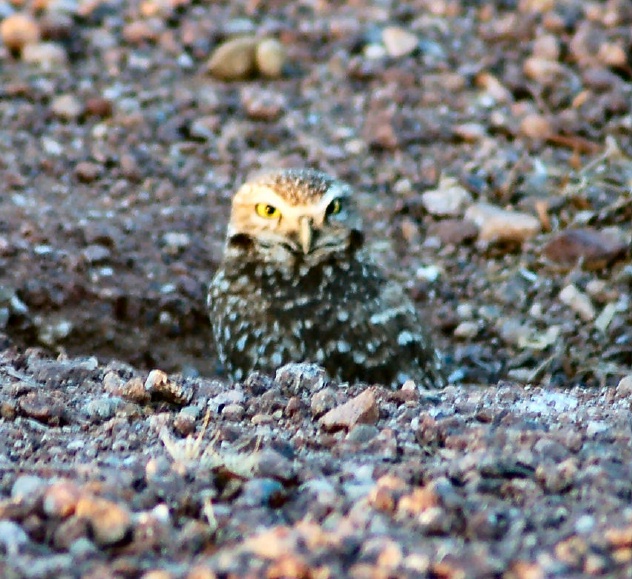 Otherwise, the past few days were normal chores again. Washing the motor home and Jeep and a little shopping. The highlight was spotting a burrow owl while we were out walking. These little ground owls are an endangered species. Tomorrow, it's moving day again. We'll finally reach our destination in Apache Junction, where we'll spend the next 6 - 7 weeks with our daughters. Our youngest will have her 21st birthday and we'll help her plan her upcoming December wedding, while our eldest is expecting her first baby in early June. I also plan to have some work done on our Jeep while we sit still for awhile.
Otherwise, the past few days were normal chores again. Washing the motor home and Jeep and a little shopping. The highlight was spotting a burrow owl while we were out walking. These little ground owls are an endangered species. Tomorrow, it's moving day again. We'll finally reach our destination in Apache Junction, where we'll spend the next 6 - 7 weeks with our daughters. Our youngest will have her 21st birthday and we'll help her plan her upcoming December wedding, while our eldest is expecting her first baby in early June. I also plan to have some work done on our Jeep while we sit still for awhile.
4/25/06: Tucson, AZ: After spending a week in Benson, we moved an entire 40 miles to Tucson. We're staying at the Davis-Monthan AFB family campground. This is a very nice military campground, rated pretty high on our other website, www.MilitaryCampgrounds.us. After arriving and getting setup, it happened again. OH NO!!!! My laptop started acting real slow again, finally crashing. That's it! We headed to a nearby computer store, paid $99 for a replacement hard drive, installed it and restored the backup and were operational again within a couple hours. It's been a few days now and the system is still purring along perfectly. We're just relaxing and taking care of some chores here. It's been awhile since the motor home and Jeep have been washed. We also have plans to visit a few friends in the upcoming days.
A reader wrote us with a question I'm sure many people are wondering about. He asks "Could you give me your take on fuel availability, price and shortages.". Our answer included our philosophy and outlook on the fuel problems. "Fuel availability and prices is something we'll have to live and deal with. We have a budget for motor home fuel, and we'll keep that same budget. Higher fuel prices just means we won't move as often. When fuel is $2 a gallon, we could move about 1300 miles a month (if we wanted to). If/when fuel reaches $4 a gallon, we'll limit moving to 650 miles a month. Fuel is an expense that we can control and not depend on. There's nothing wrong with moving slowly and enjoying an area before moving on. Our last few moves were - from Hot Well Dunes, we moved 40 miles to Benson. We stayed there for a week, and moved 40 miles to Tucson and are spending a week here. We'll probably move 250 miles into Mexico, stay a week, and move 350 miles back into the states and stay near Phoenix for 2 months. That averages to 260 miles per month. At our gas mileage and at $4 a gallon, we'd average around $173 a month." Looking at our expense report, we averaged $184 a month for motor home fuel last year. Although we don't prefer it, we could double our average fuel expense without a great financial impact.
4/20/06: Benson, AZ: Hi! You don't know how glad I am to finally be entering this log. Four days ago, my laptop started performing extremely slow. I regularly run a full virus scan, an anti-spyware scan, and an adware scan. I've also recently been running a disk de-fragmenter on the hard drive. But none of this helped with the slow performance. Finally, the laptop started to freeze and eventually I started getting the dreaded "Blue Screen of Death". When Microsoft Windows completely crashes, a blue error screen appears and tries to do a memory dump (supposedly for tech professionals to determine the cause). Luckily, when Connie's laptop crashed, I learned a lesson. I started doing regular backups to an external hard drive and had one for my laptop. Since I was getting desperate, I finally formatted the hard drive and attempted to restore from my backup. OH NO!!! An hour or so into the restore and it would lockup again!
For the past few days, I made many attempts to get my system operational. I decided to start from the beginning, erased the disk and installed Windows from the CD. This worked fine, but I didn't have all of my applications. I started to restore the data from the backup. OH NO again!!! Part way into the restore, the system would lock up again or automatically reboot. So I attempted to restore in smaller chunks. Triple OH NO!!! I could restore the data, but couldn't access it. Windows security is good enough to know that the restore wasn't to the same installation of Windows (the security ID's didn't match).
Frustrated, we decided to take a break and get away from it. A couple days ago we made a day trip to Kartchner Caverns State Park. This is a fairly new state park, opening to the public about 10 years ago. What makes these caverns more intriguing is the story behind their discovery and management. They were discovered in 1974 by a couple of amateur cave hunters. They wanted to insure the caverns were protected, but also knew they needed to be available 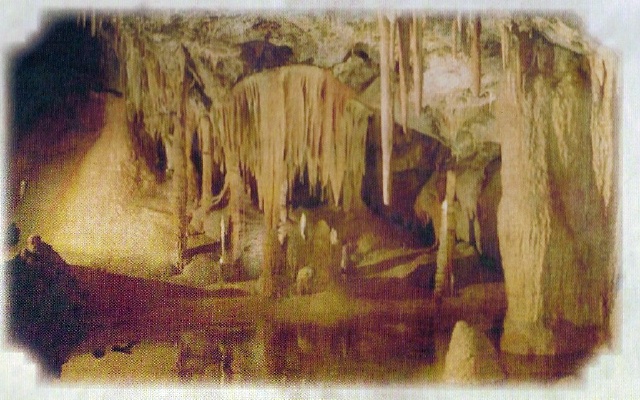 to the public. They kept their discovery secret for 4 years while they continued to explore the caverns. They finally told the land owners of the caverns, who also agreed the caverns needed to be protected. These caverns are alive. Water is still seeping into the caverns and continues to form strange rock formations. It's taken hundreds of thousands of years for some of the formations to be built, and water still drips down them continuing to make them grow. It wasn't until 1988 that the existence of the caverns became public knowledge. This was also when Arizona state purchased the land and started to make a state park of the area. Special arrangements were made to keep the caverns natural and alive. It took over 4 years before the park finally opened to the public. Only a limited number of people are allowed inside of the caverns each day, only on guided tours. You pass through 4 sets of sealed doors before you finally enter the caverns. Each set of these doors is an attempt to reduce the dry air from entering from the outside. Before entering, at one point, all visitors walk under a slight water mist. Again, in an attempt to keep the dry air out, and to reduce the dust and lint from falling off everyone. There's strict rules about touching anything. If any part of the internal caverns are touched, the tour guide marks the area with blue tape. At night, a cleaning crew comes in and cleans that area of the rocks, as well as watering down the paved walkway.
to the public. They kept their discovery secret for 4 years while they continued to explore the caverns. They finally told the land owners of the caverns, who also agreed the caverns needed to be protected. These caverns are alive. Water is still seeping into the caverns and continues to form strange rock formations. It's taken hundreds of thousands of years for some of the formations to be built, and water still drips down them continuing to make them grow. It wasn't until 1988 that the existence of the caverns became public knowledge. This was also when Arizona state purchased the land and started to make a state park of the area. Special arrangements were made to keep the caverns natural and alive. It took over 4 years before the park finally opened to the public. Only a limited number of people are allowed inside of the caverns each day, only on guided tours. You pass through 4 sets of sealed doors before you finally enter the caverns. Each set of these doors is an attempt to reduce the dry air from entering from the outside. Before entering, at one point, all visitors walk under a slight water mist. Again, in an attempt to keep the dry air out, and to reduce the dust and lint from falling off everyone. There's strict rules about touching anything. If any part of the internal caverns are touched, the tour guide marks the area with blue tape. At night, a cleaning crew comes in and cleans that area of the rocks, as well as watering down the paved walkway.
It was amazing to see these caverns. The tour guide was knowledgeable and presented the caverns in an interesting manner. The caverns weren't as colorful as we expected, but still interesting to see them still being formed. Only about 1/4 of the caverns is open to the public. There's 2 large rooms that you can tour, but not at the same time. They're different tours. During our visit, the "Big Room" was closed due to bat migration. We toured the "Rotunda" and "Throne" rooms. The tour included a very inspiring light and sound show in the Throne room. Very good! Unfortunately, photography is prohibited within the caverns.
After a day of relaxation and playing tourist, it was time to get back to fixing my computer problems. I ran extensive hard drive tests, which said everything was okay. But I decided to replace the hard drive anyway when we got to Tucson in a couple days. The system was working, but it wasn't 100% restored the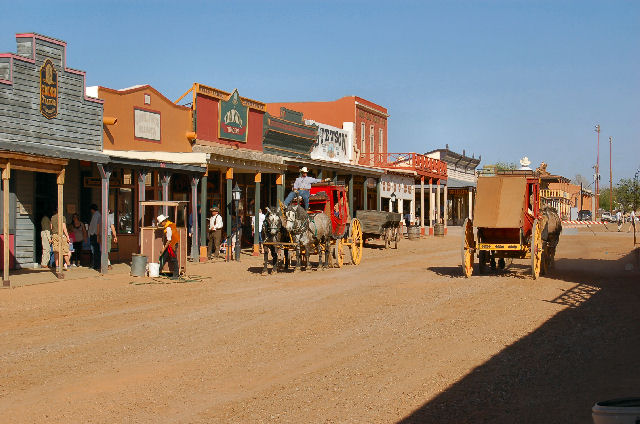 way it was before the problems. Since the system was working pretty smooth without issues, and I had already decided to replace the hard drive, I decided to try to do a full restore again. I started the restore, and we headed out to visit the famous Cowboy town of Tombstone, AZ. Tombstone is best known for the 1881 shoot-out at the O.K. Corral. Today, that famous corral and the neighboring street is a huge tourist trap. We walked around, did a little window shopping and enjoyed a nice dinner in one of the cowboy decorated diners. Unless you're a pure tourist, Tombstone is a nice place to visit for a few hours, but not a destination. A side note: there's an RV park right in the middle of town. We don't know how much they charge, but they park the RV's 5' apart! It was like a huge parking lot, and they were full! Why would a RV'er put themselves in that situation? Just a mile down the road was a much nicer RV park with large sites and it was only 25% filled. Why?
way it was before the problems. Since the system was working pretty smooth without issues, and I had already decided to replace the hard drive, I decided to try to do a full restore again. I started the restore, and we headed out to visit the famous Cowboy town of Tombstone, AZ. Tombstone is best known for the 1881 shoot-out at the O.K. Corral. Today, that famous corral and the neighboring street is a huge tourist trap. We walked around, did a little window shopping and enjoyed a nice dinner in one of the cowboy decorated diners. Unless you're a pure tourist, Tombstone is a nice place to visit for a few hours, but not a destination. A side note: there's an RV park right in the middle of town. We don't know how much they charge, but they park the RV's 5' apart! It was like a huge parking lot, and they were full! Why would a RV'er put themselves in that situation? Just a mile down the road was a much nicer RV park with large sites and it was only 25% filled. Why?
When we returned from dinner, the computer restore had completed without problems! The laptop was working smoothly and fast again. Nothing was lost and I was 100% back in operation. Hmmmm... So I scheduled a new backup again last night and awoke this morning to the system still operating smoothly. The backup completed fine. Oh well, we'll be near computer stores for the next couple months. So I'll put off the hard drive replacement, for now. Morale of the story... Have a good and frequent backup. Our external USB hard drive is great! I do a weekly full backup and a daily backup of important files. It saved my butt this time!
4/14/06: Benson, AZ: Before we left Hot Well Dunes, we spent the day geocaching and visiting the small town of Safford. Perhaps we should have stayed longer there. It was $3 a night to boondock there, but we enjoyed soaking in the hot well tubs early in the morning, and again late at night. Bit alas, we moved a little further west to Benson, AZ. We've heard many good things about the Escapee RV Club Co-op park here, that we had to stop and check it out. As a club Co-op, members can get a lifetime lease on an RV site for $10K+. The actual price depends on what improvements have been made to the site. But members only pay $10K plus the cost of the improvements. So basically, it's a fixed price. The best thing is, the price is 100% refundable when you don't renew your lease. However, there is a ~$800 yearly maintenance fee for the park, which does include the cable TV costs. Also, there's a $2 a month charge for the water/sewer, and you pay for your own electricity. The park is pretty nice, and real active. Being so popular, there's over 400 people on a waiting list to get in. We're still contemplating to get on the "list". When our name comes up on the list in 5+ years, we may want a RV lot to spend our winters (or all year) in. It costs ~$525 to get on the waiting list, but $500 of that is refundable at any time. We'll see.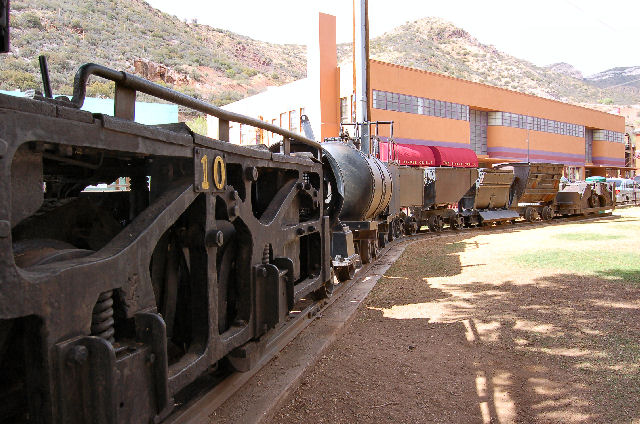
Today, we toured the old mining town of Bisbee, AZ. Since the late 1800's. this town has been mining Copper and some Silver. We hate seeing large pit mines, as they really destroy the land. But we also understand the need for mining. While in the area, we also searched for many more geocaches. It feels good to be back in Arizona, with the open space, dust, rocks, and desert. I know, it doesn't sound appealing. But we have many fond memories of Arizona and enjoy the "rugged beauty".
4/11/06: Hot Dune Wells, AZ: Before we headed to the Fort Davis area, many people suggested we also tour the McDonald Observatory, which was only 15 miles away from Ft. Davis. Friends Jim and Edna Hutchinson also showed up to spend a few days at Fort Davis. Before we left the area, we spent an afternoon touring the McDonald Observatory and a couple of their large telescopes. We learned that their main concentration here is spectroscopy astronomy, which is studying the stars colors. Most of the  telescopes here are configured with spectrographs to display the colors of the objects they look at. Not the usual optical (visual) star gazing. By analyzing the colors in different spectrum's, they can determine the size, rotation, speed, and direction of a star. You can't do this just by looking optically at a star. The McDonald Observatory is ran by the University of Texas at Austin. We toured their large 107" mirror telescope, which is now the 11th largest telescope in the world. It was the second largest when it was built. It's pretty impressive to see how they handle it. We also
telescopes here are configured with spectrographs to display the colors of the objects they look at. Not the usual optical (visual) star gazing. By analyzing the colors in different spectrum's, they can determine the size, rotation, speed, and direction of a star. You can't do this just by looking optically at a star. The McDonald Observatory is ran by the University of Texas at Austin. We toured their large 107" mirror telescope, which is now the 11th largest telescope in the world. It was the second largest when it was built. It's pretty impressive to see how they handle it. We also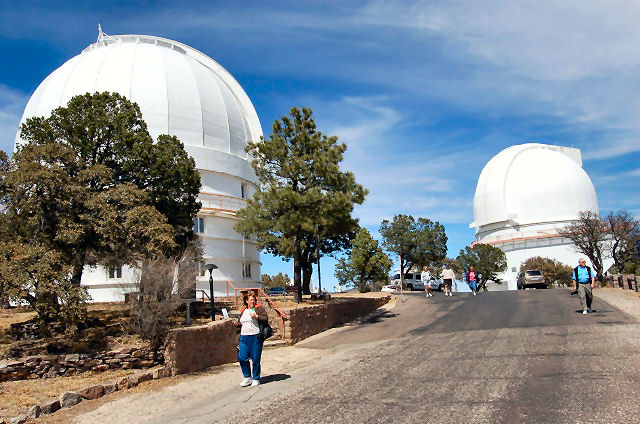 toured their 9.2 meter telescope, which is now the 4th largest in the world. But this telescope is very different than the usual mirrors in a large tube telescope. This one consists of 91mirror segments, individually controlled and placed together to form the large mirror. Instead of a scope looking down a large tube, and a tube that slowly moves to compensate for earth's rotation, this telescope is fixed, in an open structure (no tube), and the site is above the mirrors and moves. VERY different in the way it operates and the way it looks, but it was also VERY much cheaper to build (at about 15% - 20% the cost of a traditional telescope) and maintain. We also came back at 9:30pm to attend a "Star Party". It was fairly overcast, but we did get to see quite a few stars, Jupiter, and some close up views of the Moon. In addition to to viewing using a half dozen telescopes, they had a good briefing in the theater. But it would have been better if it was a clear sky with no moon.
toured their 9.2 meter telescope, which is now the 4th largest in the world. But this telescope is very different than the usual mirrors in a large tube telescope. This one consists of 91mirror segments, individually controlled and placed together to form the large mirror. Instead of a scope looking down a large tube, and a tube that slowly moves to compensate for earth's rotation, this telescope is fixed, in an open structure (no tube), and the site is above the mirrors and moves. VERY different in the way it operates and the way it looks, but it was also VERY much cheaper to build (at about 15% - 20% the cost of a traditional telescope) and maintain. We also came back at 9:30pm to attend a "Star Party". It was fairly overcast, but we did get to see quite a few stars, Jupiter, and some close up views of the Moon. In addition to to viewing using a half dozen telescopes, they had a good briefing in the theater. But it would have been better if it was a clear sky with no moon.
After leaving the Fort Davis area, we moved further west to El Paso, TX. We stayed at the Fort Bliss Army RV Park for a few days. A nice park, but right on a noisy freeway. We've been to El Paso many times before, as well as the neighboring Mexican town of Juarez. On this trip, we stopped long enough to catch 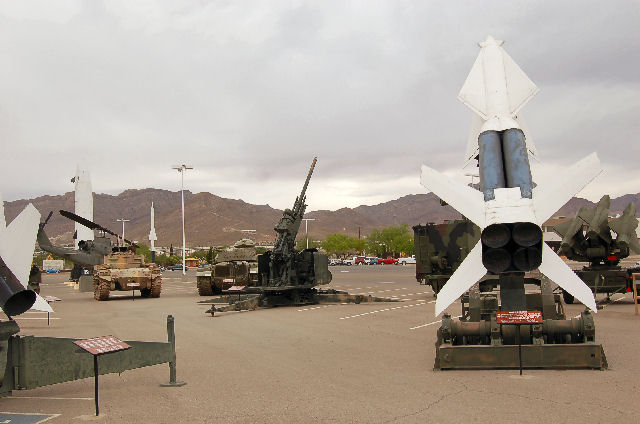 up on laundry and tour Ft. Bliss and it's 2 museums. Ft. Bliss is home of the Army's Air Defense school. They have a good Air Defense museum, with many displays of the various weapons used. The base also has a mapped driving tour. Being an old Calvary post, many of the structures were built in the late 1800's. The driving tour took us around the base, pointing out historic buildings, their past uses, and their current uses. It was interesting to see old stables and hay lofts, now used as classrooms. An old bakery is now the Synagogue. The current Fort Bliss is actually the 6th location of the Fort. The first five were small, with the current location being establish in the mid 1800's for settler's protection during the Indian conflicts.
up on laundry and tour Ft. Bliss and it's 2 museums. Ft. Bliss is home of the Army's Air Defense school. They have a good Air Defense museum, with many displays of the various weapons used. The base also has a mapped driving tour. Being an old Calvary post, many of the structures were built in the late 1800's. The driving tour took us around the base, pointing out historic buildings, their past uses, and their current uses. It was interesting to see old stables and hay lofts, now used as classrooms. An old bakery is now the Synagogue. The current Fort Bliss is actually the 6th location of the Fort. The first five were small, with the current location being establish in the mid 1800's for settler's protection during the Indian conflicts.
To finally catch us up on the past few days, we returned to Arizona today. We left Arizona over 18 months ago. We stopped at one of our favorite boondocking location near Bowie, AZ. It's a BLM area called Hot Well Dunes. Dry camping, not many people, and a natural hot well that has been captured into a couple of hot tubs. Life is VERY slow and laid back here!
4/6/06: Davis Mountains State Park, Fort Davis, TX: While staying in Big Bend, friends Jim and Edna Hutchinson and John and Kathy Boddy also came into the campground to spend a couple nights. We enjoyed some great "social hours/dinners" in the evenings with them before we headed to Fort Davis, a 130 miles away. We arrived here a couple days ago and the weather is much nicer. Just a tad warm during the day, but we now have electric hookups to run the A/C. Our main reason for coming to this part of Texas was to tour Fort Davis, a key post in the development and history of the Southwest. We spent over 3 hours touring the fort yesterday, which was first garrisoned from 1854 to 1861 before Confederate troops occupied it for a year.
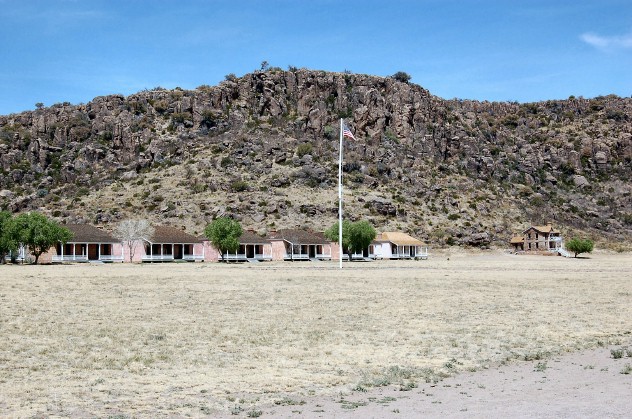 Union troops took possession again in 1862, but quickly abandoned it. It lay deserted for 5 years before a new post was built on the same location in 1867. Fort Davis's primary role of safeguarding the west Texas frontier against the Comanche's and Apaches continued until 1881. At the fort's peak in 1880, there were over 100 structures and quarters for more than 400 soldiers. The fort was finally abandoned in 1891.
Union troops took possession again in 1862, but quickly abandoned it. It lay deserted for 5 years before a new post was built on the same location in 1867. Fort Davis's primary role of safeguarding the west Texas frontier against the Comanche's and Apaches continued until 1881. At the fort's peak in 1880, there were over 100 structures and quarters for more than 400 soldiers. The fort was finally abandoned in 1891.
Civilian upkeep, moderate weather, and efforts by a private owner to maintain some of the buildings, spared Fort Davis the rapid deterioration that befell most abandoned frontier posts. After the fort became a national historic site in 1963, there has been a continuing program of restoration and preservation, managing to save many of the original structures. It is one of the best preserved Army posts from the late 1800's. We greatly enjoyed walking the grounds of this historic fort. There's over 2 dozen buildings standing, some completely restored and decorated with authentic household items and equipment for the times. The park periodically played bugle calls, which only heightened our senses as we imagined the two regiments of Buffalo Soldiers posted here forming up on the parade grounds.
most abandoned frontier posts. After the fort became a national historic site in 1963, there has been a continuing program of restoration and preservation, managing to save many of the original structures. It is one of the best preserved Army posts from the late 1800's. We greatly enjoyed walking the grounds of this historic fort. There's over 2 dozen buildings standing, some completely restored and decorated with authentic household items and equipment for the times. The park periodically played bugle calls, which only heightened our senses as we imagined the two regiments of Buffalo Soldiers posted here forming up on the parade grounds.
4/2/06: Big Bend National Park, TX: Yesterday, we got off the beaten path and ventured deep into the back country of Big Bend. There's plenty of "high-clearance" dirt roads with plenty of back-country campsites. We drove back as far away from 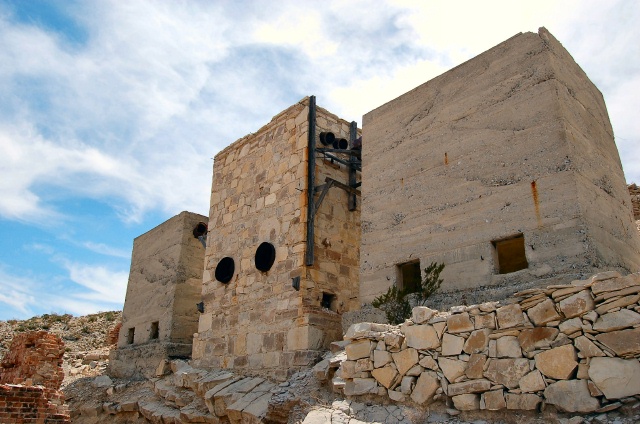 civilization as we could. On our route, we stopped at the Mariscal Mine. This quicksilver mine produced 1,400 seventy-six pound flasks of mercury between 1900 to 1943. This was nearly a quarter of the total produced in the United States! The mine ruins are in fairly good shape and the park has an excellent brochure explaining the mine and it's history. We had visited another cinnabar mine in Arizona and was curious about the process of extracting mercury. Cinnabar is the ore containing mercury and must be heated to release elemental mercury from the compound mercury sulfide. Bottom line, we now have a much better understanding of the structures at these mines and their uses.
civilization as we could. On our route, we stopped at the Mariscal Mine. This quicksilver mine produced 1,400 seventy-six pound flasks of mercury between 1900 to 1943. This was nearly a quarter of the total produced in the United States! The mine ruins are in fairly good shape and the park has an excellent brochure explaining the mine and it's history. We had visited another cinnabar mine in Arizona and was curious about the process of extracting mercury. Cinnabar is the ore containing mercury and must be heated to release elemental mercury from the compound mercury sulfide. Bottom line, we now have a much better understanding of the structures at these mines and their uses.
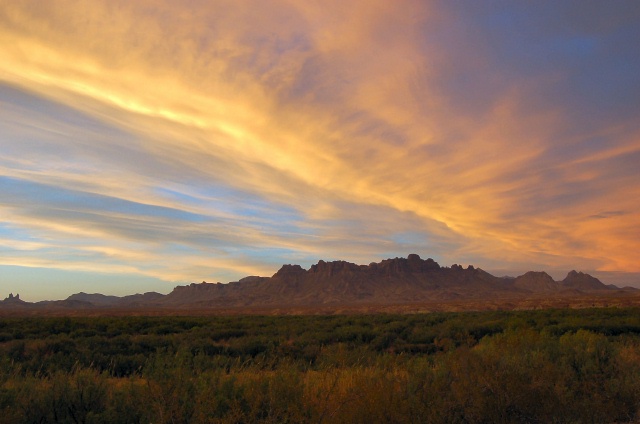 We greatly enjoyed our night out in the wild. Once we left the mine ruins, we never saw another person until we were back near
We greatly enjoyed our night out in the wild. Once we left the mine ruins, we never saw another person until we were back near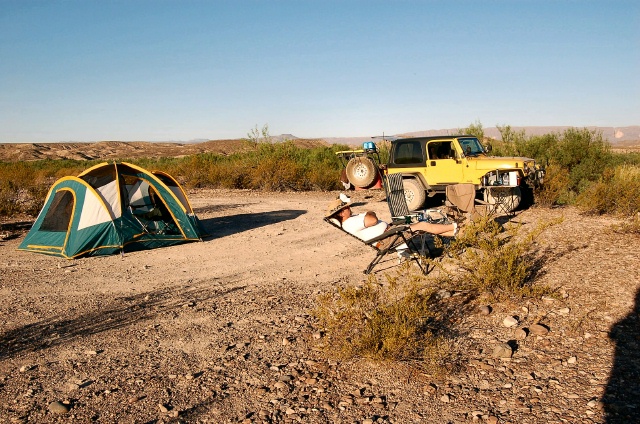 pavement. Our remote campsite near the Rio Grande river was quiet and private. Although it was pretty hot at first, the evening brought cooler temperatures. We enjoyed kicking back and watching the sunset, then watching the growing amount of stars. Since the weather was mild, we left the topper off our tent. This allowed us to look up into the heavens all night long through the screened roof. We'd sleep for a couple hours, awake and be mesmerized by the night sky, then repeat the process until dawn.
pavement. Our remote campsite near the Rio Grande river was quiet and private. Although it was pretty hot at first, the evening brought cooler temperatures. We enjoyed kicking back and watching the sunset, then watching the growing amount of stars. Since the weather was mild, we left the topper off our tent. This allowed us to look up into the heavens all night long through the screened roof. We'd sleep for a couple hours, awake and be mesmerized by the night sky, then repeat the process until dawn.
When you subscribe to the blog, we will send you an e-mail when there are new updates on the site so you wouldn't miss them.
Follow